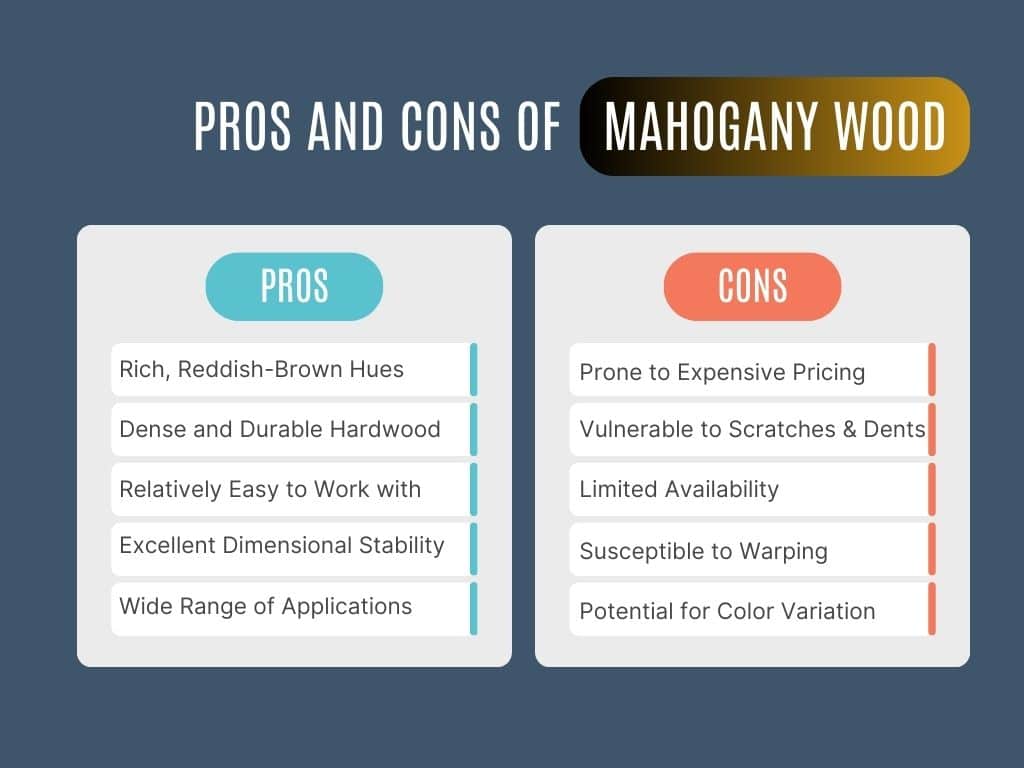Mahogany wood has long been esteemed for its beauty, durability, and versatility in various applications, ranging from furniture crafting to interior design. However, like any material, it comes with its own set of advantages and disadvantages. In this comprehensive guide, we’ll delve into the characteristics of mahogany wood, and its uses, and weigh its pros and cons to help you make informed decisions for your projects.

Advantages of Mahogany Wood
- Aesthetics: One of the most prominent advantages of mahogany wood is its stunning appearance. It boasts a rich, reddish-brown hue that darkens over time, enhancing its elegance and sophistication. Its straight, fine grain adds to its visual appeal, making it a preferred choice for high-end furniture and interior finishes.
- Durability: It is renowned for its exceptional durability and resistance to rot, decay, and pests. Its natural oils provide inherent protection against moisture, ensuring longevity even in challenging environments. This durability makes it ideal for outdoor furniture, decking, and marine applications.
- Workability: Woodworkers appreciate mahogany for its excellent workability. It machines, sands, and finishes well, allowing intricate detailing and smooth surfaces. Whether crafting intricate furniture designs or architectural elements, mahogany offers versatility and precision in fabrication.
- Stability: Unlike some other woods prone to warping or twisting, mahogany exhibits remarkable stability. It maintains its shape and dimensional integrity, reducing the risk of structural issues over time. This stability is particularly advantageous for furniture making and interior installations.
- Luxurious Feel: Mahogany wood has a luxurious feel and weight that exudes quality and craftsmanship. Its density adds to its substantial feel, conveying a sense of opulence and prestige in furniture pieces and architectural accents.
Disadvantages of Mahogany Wood
- Cost: One of the primary drawbacks of mahogany wood is its relatively high cost compared to other wood species. Its premium quality and scarcity contribute to its elevated price tag, making it less accessible for budget-conscious projects.
- Sustainability Concerns: Mahogany trees, particularly those sourced from tropical regions, face sustainability challenges due to overharvesting and deforestation. Irresponsible logging practices can lead to habitat destruction and loss of biodiversity, prompting concerns about the environmental impact of mahogany wood extraction.
- Weight: While the weight of mahogany contributes to its perceived quality, it can also be a disadvantage in certain applications. Heavyweight furniture pieces may pose challenges during transportation, installation, or rearrangement, requiring additional effort and resources.
- Color Variation: Although prized for its rich coloration, mahogany wood may exhibit variation in tone and grain pattern, especially in different cuts and sources. Matching pieces for uniformity in large-scale projects can be challenging, requiring meticulous selection and sorting.
- Maintenance Requirements: While mahogany is naturally resistant to decay and insects, proper maintenance is still essential to preserve its beauty and integrity. Regular cleaning, refinishing, and protection against moisture are necessary to prolong its lifespan and maintain its aesthetic appeal.
Conclusion
Mahogany wood offers a compelling combination of beauty, durability, and workability, making it a preferred choice for various applications in woodworking and interior design. Despite its advantages, considerations such as cost, sustainability, and maintenance requirements underscore the importance of informed decision-making. By weighing the pros and cons outlined in this guide, you can confidently incorporate mahogany wood into your projects while understanding its inherent characteristics and limitations.
For further insights into the world of timber and wood-related information, Timber Explore serves as an invaluable resource. Whether you’re a seasoned woodworker or a novice enthusiast, Timber Explore provides a wealth of knowledge to guide you through the selection, usage, and maintenance of various wood species, including mahogany.

